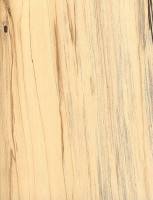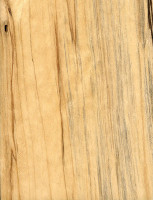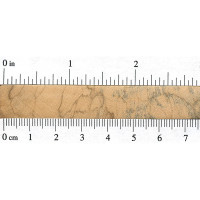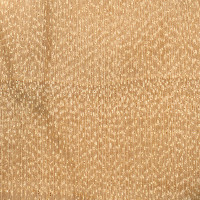 |
Common Name(s): Gray Birch Scientific Name: Betula populifolia Distribution: Northeastern North America Tree Size: 20-40 ft (6-12 m) tall, 1 ft (.3 m) trunk diameter Average Dried Weight: 35 lbs/ft3 (560 kg/m3) Specific Gravity (Basic, 12% MC): .45, .56 Janka Hardness: 760 lbf (3,380 N) Modulus of Rupture: 9,800 lbf/in2 (67.6 MPa) Elastic Modulus: 1,150,000 lbf/in2 (7.93 GPa) Crushing Strength: 4,870 lbf/in2 33.6- MPa) Shrinkage: Radial: 5.2%, Tangential: 9.5%, Volumetric: 14.7%, T/R Ratio: 1.8 |
Color/Appearance: Heartwood tends to be a light reddish brown, with nearly white sapwood. Occasionally figured pieces are available with a wide, shallow curl similar to the curl found in Cherry. There is virtually no color distinction between annual growth rings, giving Birch a somewhat dull, uniform appearance.
Grain/Texture: Grain is generally straight or slightly wavy, with a fine, even texture. Low natural luster.
Endgrain: Diffuse-porous; primarily radial multiples; medium pores in no specific arrangement, moderately numerous to numerous; parenchyma marginal, and sometimes diffuse-in-aggregates (faintly visible with lens); narrow rays, spacing fairly close to close.
Rot Resistance: Birch is perishable, and will readily rot and decay if exposed to the elements. The wood is also susceptible to insect attack.
Workability: Generally easy to work with hand and machine tools, though boards with wild grain can cause grain tearout during machining operations. Turns, glues, and finishes well.
Odor: No characteristic odor.
Allergies/Toxicity: Birch in the Betula genus has been reported as a sensitizer. Usually most common reactions simply include skin and respiratory irritation. See the articles Wood Allergies and Toxicity and Wood Dust Safety for more information.
Pricing/Availability: Likely to be rather economical in most instances. Figured boards can be more expensive, but normally plain birch lumber is in the same price range as maple or oak.
Sustainability: This wood species is not listed in the CITES Appendices or on the IUCN Red List of Threatened Species.
Common Uses: Plywood, boxes, crates, turned objects, interior trim, and other small specialty wood items.
Comments: Birch is one of the most widely used woods for veneer and plywood worldwide. Besides regular sheets of plywood, Birch veneer is also used for doors, furniture, and paneling.





Apparently the Penobscot tribe use this wood to make warclubs, which I think is odd because Gray birch is not that dense or heavy, they have access to yellow birch Which has better properties so why not use that wood instead. I’m Guessing they use the gray birch clubs for ceremonies And dances, and They use the yellow birch for clubs that would be used in actual combat.
I had a log of gray birch and I needed wood for a small project, so I worked with birch wood for the first time. I found gray birch wood is relatively easy to work with (to saw and to sand).